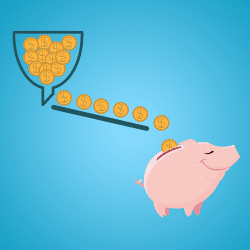
Businesses don’t get a headache over too much money invested in online marketing, but over too much money wasted on online marketing. How can a business ensure that their online marketing dollar is well-spent? Analyzing conversion data.
Scrutinizing the most relevant conversion metrics indicates what performs well and what doesn’t. The operative word here is the most relevant. If you don’t know what to look for in the web analytics tools, the numbers will just seem like messages from deep space.
But, let’s slow down 10 seconds. First of all – what’s a conversion? Conversions are most frequently understood as actions that directly bring in revenue, e.g. making a purchase. It’s beyond argument that revenue is the staff of life for a business, but tracking only direct revenue-tied conversions can get you into a situation where you can’t see the forest for the trees. There are many actions that indirectly contribute to revenue.
What actions can be followed as conversions?
- Newsletter subscriptions
- Completing contact forms
- Asking for live chat
- Measuring time spent on site or the number of pages visited
- Watching videos
- Downloading resources, brochures, product info…
- Clicking to see the business’s social network profile
- Completing a survey
That being said, let’s see what figures in web analytics you can and should use to inform your conversion optimization.
Traffic sources
Where are the visitors coming from? There are three essential traffic sources:
- Search traffic – when the visitors reach the website through search engine results
- Referral traffic – when visitors come to the website through a link on another site
- Direct traffic – when visitors type the exact business URL in the address bar
Analysis of these sources should tell you where there is room for improvement. Every source has its own value and should be addressed on its own merits when devising a conversion optimization strategy.
New visitors
You know how you can always spot a tourist in a city? The parallel can be drawn to new or unique visitors to your website. Differentiating between new and returning visitors in your conversion optimization efforts is vital to improving the experience your users have. It is also likely to produce drastic effects on your bounce rate.
Return visitors
There are visitors who come back to your site even though they didn’t convert the first time round. Now you have an opportunity to convince them to convert. The question is – why did they return? And why didn’t they convert when they first reached the site?
Interactions per visit
Examining the quality of visits is valuable even when (or especially when) the visitors didn’t convert. How many pages do the visitors go to? How much time do they spend there? Which pages have the highest bounce rate? Do they interact with the pages in some way, e.g. leave comments or share the page? Knowing this information can signal where you need to enhance the user experience.
Value per visit
This indicator is not something that lends itself to straightforward calculation, but it’s important to bear in mind the tangible and intangible value per visit. Tangible value is whether a visitor performed the desired action (converted), the most notable one being making a purchase. Sometimes though, you can also monetize another sort of conversion. If you know from experience that around 10% of those who download a product brochure eventually make the purchase, you get an idea of the visit value. However, there are many intangible values that visitors create, e.g. when they share your blog or spread the word-of-mouth.
Bounce rate
Bounce rate is the percentage of unique visitors that leave the website quickly without any interactions. Bounce rate implies that visitors aren’t getting what they wanted or expected. The factors are numerous – the landing page isn’t optimized for conversion, it takes too long to load or the traffic is directed from an irrelevant source. E-commerce sites call this abandonment rates, which means the situation when users leave their shopping carts without finalizing the purchase. Reducing the bounce rate is closely related to improving the above mentioned aspects like new and return visitors, engagement, traffic sources and value per visit. It’s important to analyze at what point of the conversion process the visitor clicks away – is it the entrance pages or the exit pages?
Gleaning insights from these metrics and shaping your conversion optimization accordingly can be the key to unleashing your profit potential.
Free SEO Audit Tool
See how optimized a specific web page, landing page, or blog post is for an exact keyword or phrase

